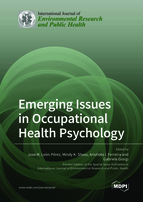Emerging Issues in Occupational Health Psychology
A special issue of International Journal of Environmental Research and Public Health (ISSN 1660-4601). This special issue belongs to the section "Occupational Safety and Health".
Deadline for manuscript submissions: closed (31 May 2021) | Viewed by 121982
Special Issue Editors
Interests: psychosocial risks at work; interpersonal conflicts; stressor-strain relationship; intervention effectiveness; health promotion.
Special Issues, Collections and Topics in MDPI journals
Interests: work stress; counterproductive work behavior; job insecurity; adaptability; interpersonal interactions at work
Interests: presenteeism; recruitment and selection; assessment; intervention effectiveness; cyber-bullying
Interests: workplace health and safety; psychological health; workplace innovation; future of work
Special Issues, Collections and Topics in MDPI journals
Special Issue Information
Dear Colleagues,
The world of work is changing dramatically due to continuous technological advancements and globalization (the so-called ‘industry 4.0’), the health crisis due to the COVID-19 outbreak, and the looming ongoing global economic crisis, which have forced adaptation to new ways of organizing work that were only timidly incorporated during the last few decades (e.g., working from home and teleworking), or social movements such as a renewed feminist movement or those trying to offer more sustainable alternatives to the current neoliberalist economic model and the demand-driven manufacturing system, among other factors.
All these factors have contributed to the emergence of new psychosocial risks for employees’ health and well-being, which are challenging the existing theoretical models and evidence-based practices in Occupational Health Psychology. Moreover, several studies have shown that workers’ health and well-being can be at higher risk when organizations face relevant changes and economic turbulence (Giorgi, Leon-Perez, & Shoss, 2015). Therefore, this Special Issue on “Emerging Issues in Occupational Health Psychology” in the International Journal of Environmental Research and Public Health aims to publish manuscripts that contribute to: (1) a better understanding of new issues and challenges for Occupational Health Psychology in the post-COVID era; and (2) implementing measures to develop more sustainable and healthy organizations.
We welcome original research papers, brief reports, and review articles. In particular, we invite the submission of empirical papers that offer strong theoretical approaches, apply rigorous methodological standards (e.g., longitudinal and temporal multilevel designs, or studies that combine multiple sources of information), and provide information about effective measures and interventions. We will accept manuscripts from different disciplines, including organizational psychology, occupational health and safety, epidemiology, human resources management, sociology, or preventive medicine. Topics of interest to this Special Issue include, but are not limited to:
- new factors and processes relevant to employees’ health and well-being;
- contextual factors and socioeconomic factors that impact upon employees’ behavior and well-being;
- multilevel perspectives in Occupational Health Psychology (employees, leaders, teams, organizations, sectors, countries);
- changes in relationships between employees’ behavior and their colleagues or customers over time;
- methodological advances and the use of innovative technologies (such as virtual reality, fMRI, eye-tracking, and cortisol measurements) to improve employees’ health and well-being;
- non-linear relationships between psychosocial risk factors and health;
- examining the return-on-investment and impact of occupational health and safety measures; and
- examining the effectiveness of online and virtual interventions to improve employees’ well-being
Dr. Jose M. León-Pérez
Dr. Mindy K. Shoss
Dr. Aristides I. Ferreira
Dr. Gabriele Giorgi
Guest Editors
Manuscript Submission Information
Manuscripts should be submitted online at www.mdpi.com by registering and logging in to this website. Once you are registered, click here to go to the submission form. Manuscripts can be submitted until the deadline. All submissions that pass pre-check are peer-reviewed. Accepted papers will be published continuously in the journal (as soon as accepted) and will be listed together on the special issue website. Research articles, review articles as well as short communications are invited. For planned papers, a title and short abstract (about 100 words) can be sent to the Editorial Office for announcement on this website.
Submitted manuscripts should not have been published previously, nor be under consideration for publication elsewhere (except conference proceedings papers). All manuscripts are thoroughly refereed through a single-blind peer-review process. A guide for authors and other relevant information for submission of manuscripts is available on the Instructions for Authors page. International Journal of Environmental Research and Public Health is an international peer-reviewed open access monthly journal published by MDPI.
Please visit the Instructions for Authors page before submitting a manuscript. The Article Processing Charge (APC) for publication in this open access journal is 2500 CHF (Swiss Francs). Submitted papers should be well formatted and use good English. Authors may use MDPI's English editing service prior to publication or during author revisions.
Keywords
- Employees’ health and well-being
- Work stressors
- Psychosocial risks
- Changing environments, Organizational development
- Health and safety







